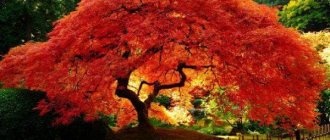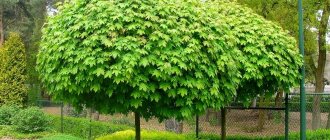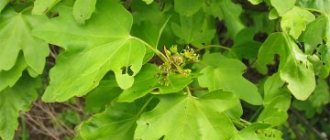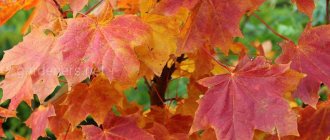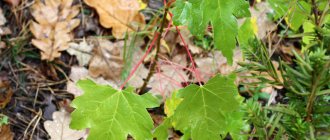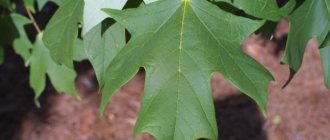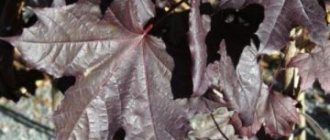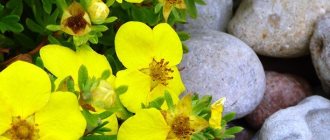A fancifully curved, openwork crown, thin fan-shaped carved leaves, bright carmine color in the fall - this tree knows how to attract attention. It looks elegant as a single composition and at the same time fits perfectly into flower beds and mixboards. Despite all the difficulties of caring for it in the conditions of central Russia, gardeners patiently continue to try to grow this oriental beauty, whose name is Japanese maple, on their plots.
Japanese red fan maple. Description and varieties of red maple
Red Japanese maples include: palmate, fan and Japanese maples, and many more varieties that were bred by breeders based on the above.
From the name of the tree you can understand that the birthplace of the Japanese maple is the Land of the Rising Sun. They differ from each other by carved leaves, which have purple or bright orange colors and shades, and another difference is the crown.
The size of the trees depends on their type; they are three meters wide and up to eight meters high. Palm maples can be taller, while fan maples are a low-growing species. The flowers of red maple are small, their color is red or yellow-green, the color depends on the variety. After flowering, the flowers turn into lionfish seeds, these seeds are scattered over many kilometers and later new trees grow from them. These trees are very beautiful and will decorate any garden or park.
Types of trees:
- Japanese fan. This tree has several varieties, they are small, have a crown of a very original shape, the leaves are golden or red, they are very similar to a lace fan.
- Palm-shaped, red Japanese variety. This species is the most beautiful among Japanese maples, this is so because its leaves remain purple in summer and autumn. They are also very beautifully shaped, they can be either five-fingered or nine-fingered, the leaves are made up of long lobes. This species grows very slowly, can reach five meters in height, and the crown diameter is approximately three meters. The flowers of this tree are red and bloom begins in June.
Japanese. This plant has very beautiful and graceful leaves. The leaves change color from spring to autumn, that is, the entire growing season. In spring they are bright green, and in autumn they are yellow, orange, burgundy and cherry. This variety of trees is very afraid of frost, which is why they are often grown in greenhouses and winter gardens.
In addition to the above varieties, there are many hybrid forms that were bred in Japan. Here are some of them:
- The species "Bloodgood" differs from others in its inky black leaves.
- Variety "Beni Kava". This tree has ruby bark and bright scarlet or fiery red leaves.
- The Katsura species has red leaves that turn green in the summer and turn golden in the fall.
- Species "Nicholsonii". Its leaves are green in summer and change into brick-red in autumn.
- Variety "Aconitifolium". This tree is multi-stemmed, has curved branches and dark red leaves.
- The species "Mikawa yatsubusa" is a small tree, approximately one and a half meters in height, it is dense with a squat crown. The leaf blades are thin and needle-shaped, bright green in summer, and orange-scarlet in autumn.
- Species "Shino Buga Oka", this species reaches only one meter in height. The tree is incredibly spreading. It has decorative leaves that are bright green in summer and yellow-orange in autumn.
Shirasawa's species - this maple is incredibly small, its height is only one and a half meters. It has wide leaves with a border along the edges, their color is yellow-orange.
Tips for caring for wood
Care and planting are individual for each type of plant. Many of them prefer the sun, but at the same time do not like direct sultry rays. This does not apply to those trees that have double colored leaves - they prefer shade. Please keep in mind:
- Japanese maple is not afraid of drafts and strong winds. If the climatic conditions in your region are cold, then the tree must be carefully covered for the winter. The ideal material for insulating maple is soft and warm garden fleece.
- In winter, shake off snow from branches, as they may break due to the weight. Do not touch branches covered with ice crust after the winter thaw; they are easily damaged.
- When forming a maple crown, the branches need to be cut off at the beginning of growth, then only the diseased and damaged parts need to be cut off.
In the case when the crown of a tree becomes very dense and its appearance is no longer so attractive, pruning is necessary. This is done as soon as the tree sheds its leaves. This will return transparency to the crown and save the plant from fungal infection.
Japanese maple aconitifolia. Types and varieties
The genus of maples today has more than a hundred species and thousands of varieties. The category of Japanese representatives includes 2 deciduous species:
Attention! Japanese maples are found in natural conditions on the territory of the Sakhalin region, and due to their scarcity they are listed in the Red Book.
The most attractive varieties for the garden are:
- A. japonicum aconitifolium (monkshood) is a tree-like shrub that is decorated with large, deeply dissected leaves in fiery orange, burgundy and yellow shades;
A. japonicum aconitifolium
- A. japonicum vitifolium (grape-leaved) - characterized by slow growth and picturesque rounded fan-shaped foliage, turning bright crimson in autumn;
A. japonicum vitifolium
- A. palmatum sangokaku (maple with coral bark) - in addition to decorative deeply cut leaves with a pink border, it surprises with its spectacular coral-red bark;
- A. palmatum Garnet is a small graceful tree with lacy leaves and low hanging branches. The thin-lobed leaves vary in hue from deep red to dark purple, transitioning to deep crimson;
A. palmatum Garnet
- A. palmatum Katsura is a compact variety that produces purple-red flowers in early spring. In spring, the leaves are yellowish with a richer brick edging. At the height of summer, the maple changes color to an unremarkable green, and by autumn it turns orange;
A. palmatum Katsura
- A. palmatum Butterfly - sports 5-lobed silver-green foliage that sometimes curls flirtatiously. In spring you can notice pinkish touches, and in autumn the place of the silvery shade is taken by rich purple.
Growing in open ground
In order for a truly spectacular, handsome maple to grow on your site, you need to choose the right seedling at the garden center. It is best if the young plant is in a container with a protected root system. In addition, the chances of the seedling to take root in a new place will increase, because it will be planted together with the “native” soil. The best time to plant a tree is spring and autumn.
The soil in the area where the young maple will be planted must be fertile, without stagnant water. If you are not sure whether there is stagnation of water, then it is better to use drainage when planting.
Advice. In order for all the beauty of the foliage to fully manifest itself, it is better to plant Japanese maple in a sunny place.
When growing, it is necessary to take into account the fact that maple can withstand frosts down to -20°C. At lower temperatures, the tree will need shelter. In this case, you should choose low-growing maple varieties.
In spring and autumn, the plant needs mulching. In the spring, before this procedure, you should apply a slow-release fertilizer to the tree trunk. The next one will be a layer of peat, and then the mulch itself (chips or bark). Mulching helps retain moisture and protects the roots of the young plant from freezing.
Attention! Maples do not tolerate fast-acting strong fertilizers.
Japanese maple garnet. Description
Katsura maple (Acer palmatum 'Katsura', Acer palmatum var. dissectum 'Katsura'). Maple "Katsura" pleases with very bright yellow foliage. Therefore, this tree will become a real decoration for any garden, but especially for an oriental-style landscape (gravel garden, pond bank, in the middle of a lawn, etc.). It looks particularly impressive against a background of shrubs such as juniper or yew, and is also suitable for composition with azaleas and rhododendrons in the understory. It is loved for the shape of its crown and leaves. Its beauty will not leave you indifferent either! This plant is also called differently: Japanese maple or palm maple. It is a slow-growing shrub or small tree that typically reaches heights of up to 1.5 to 6 m in height. The width of the plant is 1.5-4 m. Its homeland is Japan, Korea and China. IP Kharchenko gives you the opportunity to order Japanese maple seedlings that will give you joy and warmth.
Katsura is a compact, low-growing variety. It is better known for its beautiful spring foliage. Small, palmate, 5-lobed leaves up to 2.5 cm long. They appear in spring yellow-green with orange-tinted edges. In summer they are bright green and their borders turn pink. And finally, in the fall, they take on pastel shades of orange and yellow. The leaf lobes are lanceolate, with thin tips and fine serrated edges. Fan maple flowers are small, reddish in color, collected in panicles. They appear in the spring, from April to May. They are attractive upon closer inspection, but not striking from a distance. The lionfish fruit ripens in September-October. The lionfish are red at first and then turn grey. This variety, as a rule, has a through, umbrella-shaped crown. It grows up to 4m in height during the first 10 years, and gradually the crown becomes more rounded with age. It grows slowly and when it reaches only about 2 m in height, then it begins to spread its branches to the sides. This results in an almost equal size in height and width. The plant does not require pruning, but many gardeners prefer to shape it. The small reddish flowers are somewhat attractive upon closer inspection, but not showy from a distance.
We take care of it correctly
Basic plant care includes the following items, the implementation of which is mandatory:
- Although the tree loves well-moistened soil, it should not be constantly damp. This can cause the roots to rot.
- If your area is small, no problem. The bush can take root on any plot of land, the lighting of which may not be suitable for the variety.
- Maples are not afraid of drafts.
- The tree must be pruned every spring. This procedure in the first years of the plant’s life will help it find the correct shape. In the subsequent period, you can simply remove dry and diseased branches.
- Once a month you need to carry out additional watering. About 15 liters of water per root.
- In August, it is recommended to stop all feeding.
Remember! Additional watering in no way replaces the on-demand moistening.
The quality of the tree will directly depend on the seed material.
Japanese maple palmatum. General information with descriptions of varieties
Japanese maples include palm maple (Acer palmatum), fan maple (Dissectum), and Japanese maple (Acer japonicum), as well as numerous varieties bred on their basis by breeders.
As the name suggests, Japanese maples are native to the Land of the Rising Sun. All of them are distinguished by decorative carved leaves of purple and bright orange colors and shades, and a beautiful crown structure.
The sizes of Japanese maples, depending on the type, range from 2-3 meters to 8 meters in height. Palm maples are taller, while fan maples are shorter. The flowers are not large in size and have a yellow-green or red color, which depends on the variety. The flowers produce lionfish seeds, which are scattered over long distances, growing into new trees. Many Japanese maples are distinguished by their decorative crown and bark. Due to these features, the tree becomes a real decoration of the garden or greenhouse.
In addition to the basic varieties, there are many hybrid forms bred in Japan. Each of these forms has a name that conveys the peculiarity of the variety; the main thing is to understand them correctly.
- Shirasawa maple (Acer shirasawanum) is one of the smallest, about 1.5 meters high. Its leaves are wide, with a border along the edges, and yellow-orange in color.
- The variety "Bloodgood" has a unique inky black leaf color.
- The Beni Kava variety has bright scarlet, light leaves and a fiery red, ruby hue of bark.
- The Katsura variety has red young leaves that turn green in summer and golden in autumn.
- The 'Nicholsonii' variety has green leaves in summer and brick red leaves in autumn.
- The variety "Aconitifolium" is multi-stemmed, with arching branches and dark red foliage.
- The variety "Mikawa yatsubusa" is distinguished by its small size - up to 1.5 meters, dense, squat crown. Its leaves consist of thin, needle-shaped lobes, bright green in summer and orange-scarlet in autumn.
- The variety "Shino Buga Oka" is short in height, from 1 meter to 1.2-1.3 meters in height. The plant is very spreading, with decorative leaves, bright green in summer and yellow-orange in autumn.
Where to buy seedlings, where and how to plant
You should not buy Japanese maple seeds online from unknown sellers. It is advisable to come to a nursery or store engaged in certified sales and buy a tree.
It is better to purchase a seedling in spring or autumn; you need to make sure that the bush is not damaged. It must be planted immediately.
Japanese maple varieties love diffused shade and permeable soil. There is no need to choose too alkaline soils and treat the soil with lime.
The soil should be fairly fertile or slightly acidic, and always loose.
Landing
- A hole is dug twice as large as the root system of the plant;
- Pour drainage into the hole, then humus or compost with peat;
- Moisten and straighten the roots, place the tree, sprinkle with soil and water;
- To preserve moisture, mulch the tree trunk area.
Reproduction
Produced by seeds, both in nature and under cultural conditions. Seed material must be fresh.
- Before planting, the seeds are stratified by placing them in sand (it should not be wet) and kept in a cold room all winter;
- In spring they are planted in containers with special soil; they can be treated with growth stimulants;
- In autumn, the strongest shoots are left to overwinter in a cool place in the same container, where the temperature is always above zero;
- Next spring, transplant the shoots into separate pots;
- Plant seedlings that have reached 30 centimeters in a permanent place - in open ground, a tub or a pot.
Japanese red maples can be propagated vegetatively - by grafting cuttings onto palm-shaped rootstock. This procedure often ends in failure.
Japanese maple fertilizer. Collecting and planting seeds
Japanese maple reproduces by seeds, which are collected in October. They are stratified in preparation for planting. Then they are laid out in sandy, dry soil and stored in a cool room.
In early spring, planting material is treated with a growth stimulator and sown in special containers. Over the summer, the seedlings grow well, after which they are sorted, leaving tall and strong shoots. Seedlings grown from seeds should remain indoors in their containers for their first winter. Then they are transplanted into pots, each separately. When the plants grow, they are planted in open ground.
Japanese maples are extremely spectacular ornamental trees and shrubs. Even in winter, deciduous Japanese maples captivate the eye with their unusual shape of a bare crown, reminiscent of a mushroom or umbrella, and many thin fan-shaped branches. However, the peak beauty of Japanese maples occurs in autumn, when their leaves turn stunning bright colors: red, orange, gold...
The maple genus (Acer) consists of approximately 110 species of deciduous (rarely evergreen) trees and shrubs that grow naturally in the moist forests of Europe, northern and central America, and Asia. Here we will talk only about a certain category of maples, which are usually called Japanese maples, because they originate from Japan and Korea. The group of Japanese maples includes only two species: the Japanese maple itself (Acer japonicum) and the palmate or mountain maple (Acer palmatum) with its especially decorative variety, the fan maple (Dissectum). Fan maples have dissected, feathery leaves that resemble a lace fan. Japanese maples began their victorious march in European garden culture back in the 1600s, and by 1882, 202 varieties of these trees were already known in Britain. Garden centers now offer several hundred varieties of Japanese maples, which are distinguished primarily by leaf color, which is especially spectacular in the fall when maples dramatically change color to red, gold, or orange.
Reviews from gardeners
Vazha, Sochi
Japanese maple grows slowly and naturally forms a beautiful and harmonious crown. Therefore, shaping pruning is not a necessary part of Japanese maple care. It is best to prune Japanese maple trees in early spring, when the plant is still in its dormant period, to avoid excessive sap production, which weakens the plant. Keep your Japanese maple trimmed to a minimum!
Staffo 4ka , Grodno
They overwinter in the open ground: I mulch with a thick layer of pine needles, tie up branches and wrap several layers of spunbond (I’ll show you later when I go to cover them), but sometimes it can’t be done without losses. Last year, the purchased ones spent the winter in a dark, insulated basement, where it was around 0 all winter.
Japanese maple bonsai. Japanese maple bonsai: buy at Fitosystems.ru.
The catalog of our store presents various maple bonsai trees, the price of which is lower than in other stores. If a plant of the height you need or the variety you need is not in stock, you can buy it to order with a short waiting period. We send maple bonsai to different cities, such as: St. Petersburg, Rostov-on-Don, Tver, Vladimir, Nizhny Novgorod, Kostroma, Smolensk, Tula, Sochi, Yekaterinburg, St. Petersburg and many others! You can also buy a plant by mail in our online store. Absolutely all plants are carefully packaged, and if you buy in winter, the plant is packaged with insulation and can easily be transported.
These insects feed on the plant's plant fluids and the plant's plant fluids and thus cause damage to the structure of the plant. Symptoms of the presence of cochineal can be recognized by yellowing of leaves, from Knows about spots from fading of foliage. If Coccinella is present, remove the whitish encrustation from the branches and spray the plant with specific solutions.
Does outdoor bonsai sound strange to you? We are used to growing bonsai in our homes, but few people know that many of these plants can be treated outside, especially during the beautiful season, with excellent results. We discover together what a bonsai is like outside, what their resistance is and what medicines they need.
But dwarf maple varieties for bonsai are unpretentious and seem to help a person with their formation. They do not tend to grow upward, but form a dense crown covered with small foliage that preserves its natural appearance.
